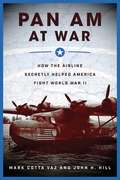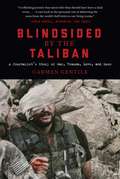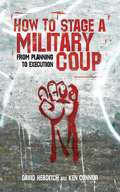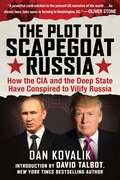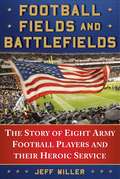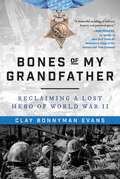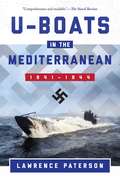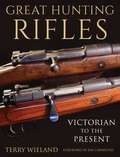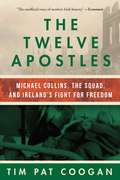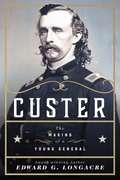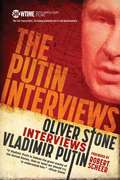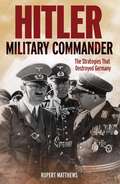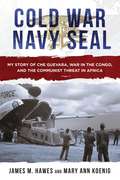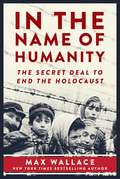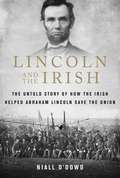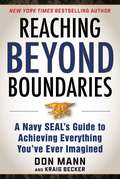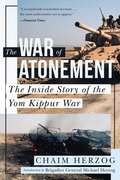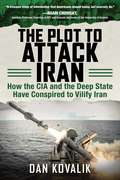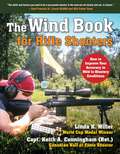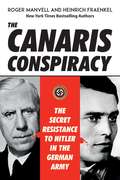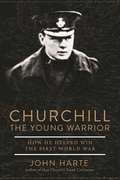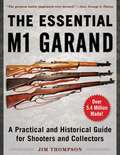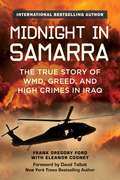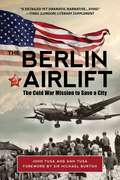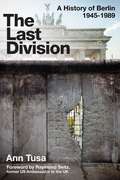- Table View
- List View
Pan Am at War: How the Airline Secretly Helped America Fight World War II
by Mark Cotta Vaz Hill John H.Pan Am at War chronicles the airline?s historic role in advancing aviation and serving America?s national interest before and during World War II. From its inception, Pan American Airways operated as the ?wings of democracy,? spanning six continents and placing the country at the leading edge of international aviation. At the same time, it was clandestinely helping to fight America?s wars. Utilizing government documents, declassified Freedom of Information Act material, and company documents, the authors have uncovered stories of Pan Am?s stunning role as an instrument of American might:The airline?s role in building air bases in Latin America and countering Axis interests that threatened the Panama CanalCreating transatlantic and trans-Africa supply lines for sending Lend-Lease equipment to BritainCooperation with Chiang Kai-shek and the Chinese nationalist government to pioneer the dangerous ?Hump? route over the Himalayas The dangerous seventeen-thousand-mile journey that took President Roosevelt to the high-stakes Casablanca Conference with Winston ChurchillThe daring flight that delivered uranium for the atomic bomb. Filled with larger-than-life characters, and revelations of the vision and technology it took to dominate the skies, Pan Am at War provides a gripping unknown history of the American Century.
Blindsided by the Taliban: A Journalist’s Story of War, Trauma, Love, and Loss
by Carmen GentileI turn to see a rocket-propelled grenade screaming toward me. The ordinance strikes me in the side of the head, instantly blinding me in one eye and crushing the right side of my face.On September 9, 2010, while embedded with an Army unit and talking with locals in a small village in eastern Afghanistan, journalist Carmen Gentile was struck in the face by a rocket propelled grenade. Inexplicably, the grenade did not explode and Gentile survived, albeit with the right side of his face shattered and blinded in one eye. Making matters worse, his engagement was on the ropes and his fiancée absent from his bedside. Blindsided by the Taliban chronicles the author’s numerous missteps and shortcomings while coming to terms with injury and a lost love. Inventive and unprecedented surgeries would ultimately save Gentile’s face and eyesight, but the depression and trauma that followed his physical and emotional injuries proved a much harder recovery. Ultimately, Gentile would find that returning to the front lines and continuing the work he loved was the only way to become whole again. As only he can, Gentile recounts the physical and mental recovery which included staring only at the ground for a month, a battle with opiate-induced constipation and a history of drug addiction, attacks by Taliban assassins born of post-traumatic stress, the Jedi-like powers of General David Petraeus, and finding normalcy under falling mortars in an Afghan valley. The result is an unapologetic, self-deprecating, occasionally cringe-worthy, and always candid account of loss and redemption in the face of the self-doubt common to us all. Blindsided by the Taliban also features the author’s photos from the field that depict the realities of life in Afghanistan for soldiers and civilians alike. #KissedbytheTaliban
How to Stage a Military Coup: From Planning to Execution
by Ken ConnorFed up with taxes? Angered and disappointed by corrupt leaders? How to Stage a Military Coup lays down practical strategies that have proven themselves around the globe. David Hebditch and Ken Connor examine, with a critical eye, successful as well as failed coup attempts throughout the twentieth century with the aim of showing their readers just what it takes to swiftly and soundly overthrow a government. Exploring coups from Nigeria, to Cuba, to Iraq, and with true stories of SAS combat written by Ken Connor, the book gives an insightful glimpse into this violent and rarely-seen world of shifting power. How to Stage a Military Coup is a unique textbook for the armchair revolutionary, as well as a practical guide for the idealist with a soft spot for the sound of artillery fire. From evaluation of the political climate and investigation of potential allies, to recruiting and training personnel, to strategies for ensuring timely transfer of power, the book leaves no aspect of the coup unexamined. This new edition features a new introduction from the authors and a new foreword from an expert in the field, and also includes appendixes, notes, and a world map of coups.
The Plot to Scapegoat Russia: How the CIA and the Deep State Have Conspired to Vilify Putin
by David Talbot Dan KovalikAn in-depth look at the decades-long effort to escalate hostilities with Russia and what it portends for the future. Since 1945, the US has justified numerous wars, interventions, and military build-ups based on the pretext of the Russian Red Menace, even after the Soviet Union collapsed at the end of 1991 and Russia stopped being Red. In fact, the two biggest post-war American conflicts, the Korean and Vietnam wars, were not, as has been frequently claimed, about stopping Soviet aggression or even influence, but about maintaining old colonial relationships. Similarly, many lesser interventions and conflicts, such as those in Latin America, were also based upon an alleged Soviet threat, which was greatly overblown or nonexistent. And now the specter of a Russian Menace has been raised again in the wake of Donald Trump’s election. The Plot to Scapegoat Russia examines the recent proliferation of stories, usually sourced from American state actors, blaming and manipulating the threat of Russia, and the long history of which this episode is but the latest chapter. It will show readers two key things: (1) the ways in which the United States has needlessly provoked Russia, especially after the collapse of the USSR, thereby squandering hopes for peace and cooperation; and (2) how Americans have lost out from this missed opportunity, and from decades of conflicts based upon false premises. These revelations, amongst other, make The Plot to Scapegoat Russia one of the timeliest reads of 2017.
Football Fields and Battlefields: The Story of Eight Army Football Players and their Heroic Service
by Jeff MillerThe 2003 Army football team achieved futility in major college play that might never be equaled, losing all 13 of its games. The squad that took the field on a frigid December 2003 day in Philadelphia for the celebrated Army-Navy game featured only eight fourth-year seniors, just a slice of the fifty energetic freshmen—“plebes” in academy vernacular—who reported to West Point amid the heat and humidity of the summer of 2000, hoping to land spots on the football team. For most of the fifty, West Point represented their best—or only—opportunity to play major college football. They were bypassed by the big-time football schools that award athletic scholarships, which aren’t available at the nation’s military academies. Making a five-year active-duty military commitment following graduation was a small price to pay during peacetime. But peacetime in America ended only days into their second year at the academy, on September 11, 2001. Those eight seniors, like virtually all of their cadet peers, maintained their commitments to the US Army in the wake of 9/11. They worked their way up from West Point’s JV football team as freshmen, earned positions on the Black Knights’ varsity team as others left the program—voluntarily or otherwise—and walked to the center of the field for the coin toss before that final opportunity for victory, against the arch-rival Midshipmen. The football field then gave way to the battlefield. Most of the eight were deployed overseas, serving at least one tour in either Iraq or Afghanistan. One won the Bronze Star, another the Purple Heart. One qualified for an elite Rangers battalion, another for the 160th special operations aviation Night Stalkers. They took on enemy fire. They grieved at the loss of brothers in arms. They hugged their loved ones tightly upon returning home. There was no more talk of football losses. They were winners.
Bones of My Grandfather: Reclaiming a Lost Hero of World War II
by Clay Bonnyman Evans“War, reclamation, and what Tim O'Brien called "the Lives of the Dead" are eternal literary themes for men. Clay Bonnyman Evans has honored that lineage with this masterful melding of military history and personal quest.”—Ron Powers, co-author of New York Times #1 bestsellers Flags of Our Fathers and True Compass, along with No One Cares About Crazy People and othersIn November 1943, Marine 1st Lt. Alexander Bonnyman, Jr. was mortally wounded while leading a successful assault on a critical Japanese fortification on the Pacific atoll of Tarawa, and posthumously awarded the Medal of Honor, the nation's highest military honor. The brutal, bloody 76-hour battle would ultimately claim the lives of more than 1,100 Marines and 5,000 Japanese forces. But Bonnyman's remains, along with those of hundreds of other Marines, were hastily buried and lost to history following the battle, and it would take an extraordinary effort by a determined group of dedicated civilians to find him. In 2010, having become disillusioned with the U.S. government's half-hearted efforts to recover the "lost Marines of Tarawa," Bonnyman's grandson, Clay Bonnyman Evans, was privileged to join the efforts of History Flight, Inc., a non-governmental organization dedicated to finding and repatriating the remains of lost U.S. service personnel. In Bones of My Grandfather, Evans tells the remarkable story of History Flight's mission to recover hundreds of Marines long lost to history in the sands of Tarawa. Even as the organization begins to unearth the physical past on a remote Pacific island, Evans begins his own quest to unearth the reclaim the true history of his grandfather, a charismatic, complicated hero whose life had been whitewashed, sanitized and diminished over the decades. On May 29, 2015, Evans knelt beside a History Flight archaeologist as she uncovered the long-lost, well-preserved remains of of his grandfather. And more than seventy years after giving his life for his country, a World War II hero finally came home.
U-Boats in the Mediterranean: 1941–1944
by Lawrence PatersonBetween September 1941 and May 1944, the Germans sent sixty-two U-boats into the Mediterranean. To get there, the boats had to pass through the Strait of Gibraltar?the British-held entry point, where nearly a third of them were sunk or forced to turn back. Of the submarines that made it into the clear, calm waters of the Mediterranean, not one of them ever made it back into the Atlantic: They were all either sunk in battle or scuttled by their own crews. In U-Boats in the Mediterranean, Lawrence Paterson puts the campaign into its strategic context, showing how it coordinated with Rommel's Afrika Korps in the Western Desert and the U-boat battle in the Atlantic. He describes the weapons and tactics the commanders used to try to overcome the difficulties of operating in the shallow waters and and how increasing Allied dominance of the air took its heavy toll. Paterson details the U-boat triumphs such as the sinking of HMS Ark Royal, and the torpedoing of the battleship HMS Barham, which provided one of the best-known images of the Second World War at sea. Making full use of firsthand accounts by veterans, official German records, and Allied archives, the book puts a spotlight on a neglected aspect of the U-boat war and shows the courage and fortitude of the men on both sides of this savage conflict.
Great Hunting Rifles: Victorian to the Present
by Terry WielandIn Great Hunting Rifles, firearms expert Terry Wieland leads the reader on a journey through the history of some of the most exquisite rifles made in the twentieth century.The rifles featured in the book, all personally owned by the author and described in loving detail, were chosen for their particular importance. Each rifle either represents a particular era of gun making, is historically important, or is simply a paragon of gun making skill. In his treatment of these special rifles, Wieland provides a close look at some individual guns that are superb in a unique way, and which illustrate high points of the twentieth century. Each chapter is dedicated to one particular rifle, and is accompanied by photographs of the author's own examples, including:James Woodward hammer double .450 Express 3 1/4" Holland & Holland hammer .500 Express 3 1/4" Haenel-Mannlicher bolt action .450 Ackley custom rifle Mannlicher-Schoenauer Model 1908 Savage Model 1899 Al Biesen custom .270 Winchester .505 Gibbs custom built on a Granite Mountain Mauser 98 And many more! Great Hunting Rifles is perfect for anyone who wants to know more about the history of those few, special rifles that have made their mark on time.
The Twelve Apostles: Michael Collins, the Squad, and Ireland's Fight for Freedom
by Tim Pat CooganIreland, 1919: When Sinn Féin proclaims Dáil Éireann the parliament of the independent Irish republic, London declares the new assembly to be illegal, and a vicious guerrilla war breaks out between republican and crown forces. Michael Collins, intelligence chief of the Irish Republican Army, creates an elite squad whose role is to assassinate British agents and undercover police. The so-called 'Twelve Apostles' will create violent mayhem, culminating in the events of 'Bloody Sunday' in November 1920. Bestselling historian Tim Pat Coogan not only tells the story of Collins' squad, he also examines the remarkable intelligence network of which it formed a part, and which helped to bring the British government to the negotiating table.
Custer: The Making of a Young General
by Edward G. LongacreThe name George Armstrong Custer looms large in American history, specifically for his leadership in the American Indian Wars and unfortunate fall at the Battle of Little Bighorn. But before his time in the West, Custer began his career fighting for the Union in the Civil War. In Custer: The Making of a Young General, legendary Civil War historian Edward G. Longacre provides fascinating insight into this often-overlooked period in Custer's life. In 1863, under the patronage of General Alfred Pleasonton, commander of the Army of the Potomac's horsemen, a young but promising twenty-three-year-old Custer rose to the unprecedented rank of brigadier general and was placed in charge of the untried Michigan Calvary Brigade. Although over time Custer would bring out excellence in his charges, eventually leading the Wolverines to prominence, his first test came just days later at Hanover, then Hunterstown, and finally Gettysburg. In these campaigns and subsequent ones, Custer's reputation for surging ahead regardless of the odds (almost always with successful results that appeared to validate his calculating recklessness) was firmly established. More than just a history book, Custer: The Making of a Young General is a study of Custer's formative years, his character and personality; his attitudes toward leadership; his tactical preferences, especially for the mounted charge; his trademark brashness and fearlessness; his relations with his subordinates; and his attitudes toward the enemy with whom he clashed repeatedly in Pennsylvania and Virginia. Custer goes into greater depth and detail than any other study of Custer's Civil War career, while firmly refuting many of the myths and misconceptions regarding his personal life and military service. Fascinating and insightful, it belongs on the shelf of every history buff.
The Putin Interviews: Oliver Stone Interviews Vladimir Putin
by Robert Scheer Oliver StoneWITH SUBSTANTIAL MATERIAL NOT INCLUDED IN THE DOCUMENTARY Academy Award winner Oliver Stone was able to secure what journalists, news organizations, and even other world leaders have long coveted: extended, unprecedented access to Russian President Vladimir Putin. The Putin Interviews are culled from more than a dozen interviews with Putin over a two-year span—never before has the Russian leader spoken in such depth or at such length with a Western interviewer. No topics are off limits in the interviews, which first occurred during Stone’s trips to meet with NSA whistleblower Edward Snowden in Moscow and most recently after the election of President Donald Trump. Prodded by Stone, Putin discusses relations between the United States and Russia, allegations of interference in the US election, and Russia’s involvement with conflicts in Syria, Ukraine, and elsewhere across the globe. Putin speaks about his rise to power and details his relationships with Presidents Clinton, George W. Bush, Obama, and Trump. The exchanges are personal, provocative, and at times surreal. At one point, Stone asks, “Why did Russia hack the election?”; at another, Stone introduces him to Stanley Kubrick’s 1964 Cold War satire "Dr. Strangelove," which the two watch together. Stone has interviewed controversial world leaders before, including Hugo Chavez, Fidel Castro, and Benjamin Netanyahu. But The Putin Interviews, in its unmediated access to one of the most enigmatic and powerful men in the world, can only be compared to the series of conversations between David Frost and Richard Nixon we now refer to as “The Nixon Interviews” of 1977. The book will also contain references and sources that give readers a deeper understanding of the topics covered in the interviews and make for a more robust reading experience.
Hitler: Military Commander
by Rupert MatthewsA comprehensive examination of Hitler’s military strategies.As Führer of the Third Reich, Hitler was responsible for deciding the German war aims in 1939. As head of the Armed Forces from February 4th, 1938, he was also responsible for the overall Wehrmacht strategy intended to achieve these aims. Hitler: Military Commander examines with impeccable detail Hitler's key military decisions during the Second World War, and assesses how far these decisions were militarily justified in the light of the intelligence available at the time. Perhaps most importantly, it tackles the larger questions of how a non-German former corporal, albeit the holder of the Iron Cross First Class, managed to take personal control of an army with the Prussian traditions of the German army; to appoint, sack, and sentence to death its generals at will, to lead it into a World War it was not prepared for; and to ultimately destroy it. Featuring black-and-white photographs, maps, biographical context, tactical analysis, and more, this new edition of Hitler: Military Commander will give readers the comprehensive overview of Hitler's military decisions and downfall.
Cold War Navy SEAL: My Story of Che Guevara, War in the Congo, and the Communist Threat in Africa
by James M. Hawes Mary Ann KoenigFor the first time, a Navy SEAL tells the story of the US's clandestine operations in North Vietnam and the Congo during the Cold War. Sometime in 1965, James Hawes landed in the Congo with cash stuffed in his socks, morphine in his bag, and a basic understanding of his mission: recruit a mercenary navy and suppress the Soviet- and Chinese-backed rebels engaged in guerilla movements against a pro-Western government. He knew the United States must preserve deniability, so he would be abandoned in any life-threatening situation; he did not know that Che Guevara attempting to export his revolution a few miles away. Cold War Navy SEAL gives unprecedented insight into a clandestine chapter in US history through the experiences of Hawes, a distinguished Navy frogman and later a CIA contractor. His journey began as an officer in the newly-formed SEAL Team 2, which then led him to Vietnam in 1964 to train hit-and-run boat teams who ran clandestine raids into North Vietnam. Those raids directly instigated the Gulf of Tonkin Incident. The CIA tapped Hawes to deploy to the Congo, where he would be tasked with creating and leading a paramilitary navy on Lake Tanganyika to disrupt guerilla action in the country. According to the US government, he did not, and could not, exist; he was on his own, 1400 miles from his closest allies, with only periodic letters via air-drop as communication. Hawes recalls recruiting and managing some of the most dangerous mercenaries in Africa, battling rebels with a crew of anti-Castro Cuban exiles, and learning what the rest of the intelligence world was dying to know: the location of Che Guevara. In vivid detail that rivals any action movie, Hawes describes how he and his team discovered Guevara leading the communist rebels on the other side and eventually forced him from the country, accomplishing a seemingly impossible mission. Complete with never-before-seen photographs and interviews with fellow operatives in the Congo, Cold War Navy SEAL is an unblinking look at a portion of Cold War history never before told.
In the Name of Humanity: The Secret Deal to End the Holocaust
by Max WallaceShortlisted for the 2018 RBC Taylor prize for literary nonfiction“A riveting tale of the previously unknown and fascinating story of the unsung angels who strove to foil the Final Solution.”—Kirkus starred reviewOn November 25, 1944, prisoners at Auschwitz heard a deafening explosion. Emerging from their barracks, they witnessed the crematoria and gas chambers--part of the largest killing machine in human history--come crashing down. Most assumed they had fallen victim to inmate sabotage and thousands silently cheered. However, the Final Solution's most efficient murder apparatus had not been felled by Jews, but rather by the ruthless architect of mass genocide, Reichsführer-SS Heinrich Himmler. It was an edict that has puzzled historians for more than six decades. Holocaust historian and New York Times bestselling author Max Wallace--a veteran interviewer for Steven Spielberg's Shoah Foundation--draws on an explosive cache of recently declassified documents and an account from the only living eyewitness to unravel the mystery. He uncovers an astounding story involving the secret negotiations of an unlikely trio--a former fascist President of Switzerland, a courageous Orthodox Jewish woman, and Himmler's Finnish osteopath--to end the Holocaust, aided by clandestine Swedish and American intelligence efforts. He documents their efforts to deceive Himmler, who, as Germany's defeat loomed, sought to enter an alliance with the West against the Soviet Union. By exploiting that fantasy and persuading Himmler to betray Hitler's orders, the group helped to prevent the liquidation of tens of thousands of Jews during the last months of the Second World War, and thwarted Hitler's plan to take "every last Jew" down with the Reich. Deeply researched and dramatically recounted, In the Name of Humanity is a remarkable tale of bravery and audacious tactics that will help rewrite the history of the Holocaust.
Lincoln and the Irish: The Untold Story of How the Irish Helped Abraham Lincoln Save the Union
by Niall O'DowdAn unprecedented narrative of the relationship that swung the Civil War. When Pickett charged at Gettysburg, it was the all-Irish Pennsylvania 69th who held fast while the surrounding regiments broke and ran. And it was Abraham Lincoln who, a year earlier at Malvern Hill, picked up a corner of one of the Irish colors, kissed it, and said, “God bless the Irish flag.” Lincoln and the Irish untangles one of the most fascinating subtexts of the Civil War: Abraham Lincoln’s relationship with the men and women coming to America to escape the Irish famine. Renowned Irish-American journalist Niall O’Dowd gives unprecedented insight into a relationship that began with mutual disdain. Lincoln saw the Irish as instinctive supporters of the Democratic opposition, while the Irish saw the English landlord class in Lincoln’s Republicans. But that dynamic would evolve, and the Lincoln whose first political actions included intimidating Irish voters at the polls would eventually hire Irish nannies and donate to the Irish famine fund. When he was voted into the White House, Lincoln surrounded himself with Irish staff, much to the chagrin of a senior aide who complained about the Hibernian cabal. And the Irish would repay Lincoln’s faith—their numbers and courage would help swing the Civil War in his favor, and among them would be some of his best generals and staunchest advocates.
Reaching Beyond Boundaries: A Navy SEAL's Guide to Achieving Everything You've Ever Imagined
by Don Mann Kraig BeckerFor the last decade, decorated Navy SEAL, accomplished athlete, and bestselling author Don Mann has been traveling across the country giving motivational talks and in the process inspiring hundreds with the secrets behind his awe-inspiring achievements. In Reaching beyond Boundaries, Mann brings his much sought-after wisdom to the page. As an elite Navy SEAL, Mann performed seemingly impossible tasks on a regular basis. Here he details the lessons he learned from his training and shows how the rest of us can apply those teachings to our daily lives in terms of learning to push beyond our internal boundaries and achieve the goals we’ve set for ourselves, both professionally and personally. Reaching Beyond Boundaries teaches how to set and conquer both micro- and macro-goals through removing excuses, having the right mindset, and learning from successes and failures. Making your dreams a reality is possible. With Reaching Beyond Boundaries you can begin to realize your fullest potential today.
The War of Atonement: The Inside Story of the Yom Kippur War (Greenhill Military Paperback Ser.)
by Chaim Herzog Brigadier General Michael HerzogThis is the authoritative account of the Israeli army’s performance in the bitter Yom Kippur War of 1973. The origins of the war amid the turbulent history of competing powers in the Middle East are fully explored, as is the build-up of Arab forces that almost inexplicably caught Israel by surprise. The author then provides a gripping narrative of the conflict itself, punctuated by firsthand accounts and interviews with combatants. The War of Atonement is full of drama and tales of inspirational bravery, as Israel defied the odds to defeat the two-pronged invasion. An analysis of the political implications of the conflict bring this epic tale to a close. For this edition Chaim Herzog’s son, Brigadier General Michael Herzog, has written an introduction which places the book in the context of his father’s achievements and gives a revealing insight into the man himself. This is the most comprehensive work on a conflict that has had major implications for our own troubled times.
The Plot to Attack Iran: How the CIA and the Deep State Have Conspired to Vilify Iran
by Dan Kovalik* “Spectacular!” * –Oliver StoneThe world has a lot of questions about the current state of affairs between the United States and Iran… How has the US undermined democracy in Iran? Is Iran really trying to develop nuclear weapons? How has US waged a terror campaign against Iran for years? How is it that the US and Israel, rather than Iran, are destabilizing the Middle East? How has Iran helped the US in the war on terror?In The Plot to Attack Iran, critically acclaimed author Dan Kovalik exposes what Americans have known about the Islamic Republic is largely based on propaganda. The 1953 coup that deposed the democratically-elected prime minister for a US-selected shah? Sold to average American citizens as a necessity to protect democracy and guard against communism. In truth, it was America’s lust for Iranian oil and power that installed the tyrannical shah. The Iranian hostage crisis that miraculously ended with Ronald Reagan’s inauguration as president? Evidence shows that Reagan negotiated with the hostage-takers to hold the hostages until his inauguration.Iran, once known as Persia, is one of the oldest nations on earth. It has a rich history and a unique culture, and is bordered by seven countries, the Caspian Sea, and the Persian Gulf. It is literally the intersection of many countries and many worlds. It has a population of eighty million people and occupies a space nearly the size of Alaska, the largest US state; it is the seventeenth largest country in the world. Over the past century, Iran’s greatest resource, and at the same time its greatest curse, has been its oil. For it is oil that has caused the United States and other world powers to systematically attempt to destroy Iran. After a greedy Iranian monarch sold all of Iran’s oil and natural gas reserves to a British financier in 1901, the West started just one of its many invasions and exploitations of the country.Using recently declassified documents and memos, as well as first-hand experience of the country, critically-acclaimed author Dan Kovalik will change the way you think about Iran, and especially what you think of US interference there. Learn how the United States vilifies its enemies, and accuses them of unspeakable horror to mask its own terrible crimes. Not only does the illuminating and important The Plot to Attack Iran delve into the current incendiary situation, but it also predicts what could happen next, and what needs to be done before it is too late.
The Wind Book for Rifle Shooters: How to Improve Your Accuracy in Mild to Blustery Conditions
by Linda K. Miller Keith A. CunninghamAll other factors being equal, it is your ability to read the wind that will make the most difference in your shooting accuracy. The better you understand the behavior of the wind, the better you will understand the behavior of your bullet. Now, champion shooters Linda K. Miller and Keith A. Cunningham reveal everything they wish they&’d known about reading the wind before they started shooting (instead of having to learn as they went along) in concise, easy-to-read terms and accompanied with handy ninety-five diagrams. The Wind Book for Rifle Shooters contains straightforward guidance on the simple thought process they use to read the wind, the techniques and tactics they use to win matches, and the underlying skills that support both. Let these champions show you how to put together a simple wind-reading toolbox for calculating wind speed, direction, deflection, and drift. Then learn how to use these tools to read flags and mirage, record and interpret your observations, and time your shots to compensate for wind. Other topics covered include: Analyzing shot placementRecording and record keepingConfidence and following your hunchesAnd much more!The essential wind-reading basics taught in this book will absolutely improve your shooting skills, whether you're a target shooter, a plinker, a hunter or a shooting professional.
The Canaris Conspiracy: The Secret Resistance to Hitler in the German Army
by Heinrich Fraenkel Roger ManvellJuly 20, 1944. Colonel Claus von Stauffenberg carried a time bomb in a briefcase into a conference with Adolf Hitler. After wedging the briefcase directly in front of Hitler under a table, Stauffenberg took his leave. Only ill luck and divine providence could have caused what happened next; a junior staffer accidentally kicked the case, moving it further from Hitler. When the bomb exploded, four died, but none was the megalomaniacal Führer. Men from all walks of German life—the army, Military Intelligence, civilian life—came together at great personal risk to conspire over a span of six years to save their beloved Germany from the clutches of a madman and halt a further descent into war. This is the incredible documented account of their work and collaboration with “Department Z,” the twenty-four individuals who operated under the leadership of Admiral Wilhelm Canaris to secretly engineer this intricate scheme to kill Adolf Hitler and take over the Third Reich. Only by a matter of minutes and inches did these courageous men fail in their daring plot, changing the course of history. Meet the conspirators and learn the plots behind The Canaris Conspiracy, a near-continuous web of planning and frustrated action which came nearer to achieving the longed-for coup d’état than anyone realizes.
Churchill The Young Warrior: How He Helped Win the First World War
by John HarteThis is the intriguing chronicle of Winston Churchill’s early years as a young soldier fighting in several different types of wars—on horseback in the cavalry at Khartoum, with saber and lance against the Dervishes at age twenty-two, in the South African war against the Boers, and finally in the First World War after he resigned as First Lord of the Admiralty, to volunteer to lead a Scottish brigade in the trenches of the Western Front, as Lieutenant-Colonel. The book also covers the failure, bloodshed, and disgrace of Gallipoli that was blamed on him, which could have led to his downfall, as well as the formative relationships he had with the two important women in his young life - his mother, Jennie, who was an eighteen-year-old woman when she married an English aristocrat, and Churchill’s young wife, Clementine. How did the events of his early life shape his subsequent life and career, making him the leader he would become? What is the mystery behind how World War I erupted, and what role did Churchill play to end it?Most readers are aware of Churchill’s leadership in World War Two, but are unaware of his contributions and experiences in World War One. Through engaging narrative non-fiction, this book paints a startlingly different picture of Winston Churchill - not the portly, conservative politician who led the UK during World War II, but rather the capable young man in his 20s and 30s, who thought of himself as a soldier saving Britain from defeat. Gaining experience in battle and developing a killer instinct and a mature worldview would serve him well as the leader of the free world.
The Essential M1 Garand: A Practical and Historical Guide for Shooters and Collectors
by Jim ThompsonThe first self-loading rifle to see widespread military use, the robust M1 Garand survived the tests of battle from World War II to Vietnam, and it remains a favorite among competition shooters and collectors to this day.In this heavily illustrated, practical history, author Jim Thompson, a longtime M1 shooter and collector, tells the complete story of the rifle's development, look, feel, and function. A thoroughly researched overview of the M1 Garand goes beyond industrial histories and provides background on manufacturers and stateside sources as well as discussing ammunition and accuracy. Detailed photo sections present:Early and World War II riflesWorld War II and postwar rebuilds (including rare postwar rifles from the US and Italy)Special purpose rifles and rarities, including sniper, match, and competition rifles plus the T26Spinoffs and derivatives, including the M14, M1A, and BM.59In addition, reprinted and heavily annotated military and National Match manuals, an updated troubleshooting chart, and a section on reloading provide valuable functional data and rules of thumb with the shooter in mind. Collectors will benefit from an extensive parts compendium.The final part of the book, dedicated to the enjoyment and maintenance of the M1, addresses some common questions about the rifle and offers detailed instruction on some expert procedures for maintaining and smoothing this wartime classic.
Midnight in Samarra: The True Story of WMD, Greed, and High Crimes in Iraq
by Eleanor Cooney Frank Gregory FordThe riveting, exclusive true story of an Iraq whistleblower who continues to be betrayed by his country, as told by an international bestselling author. Gregory Ford, an intelligence agent and medic, was in Iraq for only a short time—from the invasion in March 2003 until early June of the same year, when he was strapped to a stretcher, drugged, and “renditioned” out of Iraq in a clandestine and criminal operation at the behest of his command, who were frantically trying to silence him. But why? Midnight in Samarra is the shocking true story of one soldier’s attempt to speak up and report the abuse and torture he saw being inflicted on the local population, as well as secret, incriminating, enormous Iraqi arms stores of American-made Weapons of Mass Destructionwith bills of lading implicating, among others, famous political families. His warnings about simmering anti-American fury of the local populace were ignored and suppressed by his command; hundreds of millions of dollars in cash seized in the home of Saddam Hussein’s main banker as a result of Ford's intelligence work vanished without a trace. Ford’s information about Hussein’s location, which could have led to the dictator's apprehensionsix months before his actual capture,was also ignored and suppressed. As Ford was filing charges against his superior officers, they seized his weapons (illegal in a war zone), tried to declare him insane, abducted him by force, restrained him, administered a dangerous mind-altering drug during a Medevac flight, and tried to interrogate him while he was under. Years later, Gregory Ford is still trying to get justice. His command—and high-ups in both the military and the government—lied, dissembled, obfuscated, danced, and dodged while Ford endured libel, slander, and innuendo, feared for his life, and, nearly a decade after the drugging on the plane, learned that the chemical injected into him had done permanent damage to his heart and nervous system.Midnight in Samarra is the story of one man’s courage and conviction, and the horrifying truths of one of our most trusted and honored institutions.
The Berlin Airlift: The Cold War Mission to Save a City
by Ann Tusa John TusaA Simon & Schuster eBook. Simon & Schuster has a great book for every reader.
The Last Division: Berlin, the Wall, and the Cold War
by Ann Tusa Raymond Seitz“A brilliant paper chase—an excellent book.”—Library JournalJFK, Khrushchev, Reagan, and a city divided. Berlin has played a major role in world politics since the Nazi era and continues to be in the spotlight today as the once-again-great capital of Germany. Ann Tusa presents an engaging chronicle of the Cold War partitions of this historic city, from the political strife and administrative division by the victors against Hitler, through the building and eventual destruction of the Wall. Using newly available documents, she offers by far the fullest account to date of the political, diplomatic, and military affairs of the city, with vivid characterizations of central figures like Konrad Adenauer, Nikita Khrushchev, and British Prime Minister Harold Macmillan. Tusa's account also displays the full drama surrounding the building of the Wall, from its ramifications for world politics (including John F. Kennedy's famous response that “a wall is a hell of a lot better than a war” and Ronald Reagan’s iconic “Mr. Gorbachev, tear down this wall!”) to the experiences of ordinary Berliners and the personal tragedies they experienced as the Wall severed a living city and sundered families for generations. The result is a startling combination of historical detail and lucid style, a story that The Sunday Times of London has hailed as “not only painstakingly researched but eminently readable.”
